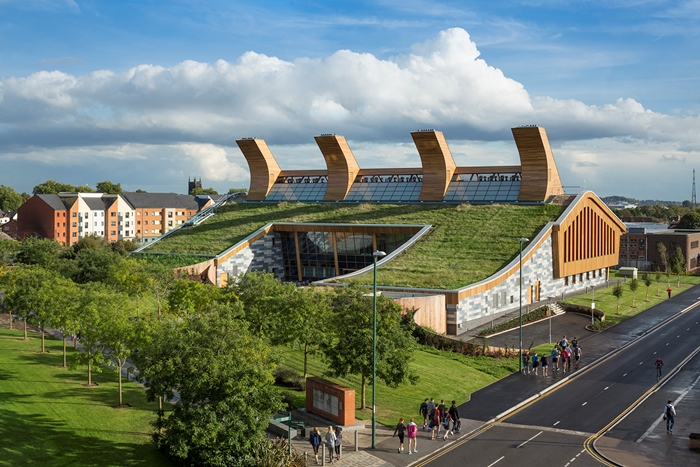
Google’s Project Sunroof is a tool that allows you to measure the benefits of rooftop solar for your home using Google Maps. It is essentially a solar calculator that educates the public on their solar opportunities with the ultimate goal of enabling solar to be more accessible. The tool has been around since 2015, informing many users how much sun hits their roofs and quantifying how much solar panels would save the user’s energy-related expenses per month. Comprehension of how this process not only benefits the user but can also lead to understanding how to develop a more sustainable future. Understanding this is a step towards becoming a LEED Green Associate or LEED AP.
Currently, Project Sunroof’s data explorer is limited to the U.S. and Germany.

In the pursuit of a more sustainable world, it is imperative to be aware of our surroundings and the potential resources we can utilize. The sun is an infinite resource that provides free energy almost anywhere in the world. Solar power systems capitalize this through the use of solar panels or other solar energy generating devices in generating renewable energy.
It is overwhelming to picture that sunshine hitting the earth in a single hour is enough to power the global economy for a full year; however, only a small fraction of that energy is captured. If all the rooftops in the world had solar panels, this could supply a surplus amount of the world’s energy needs; consequently, humanity is living under great potential to combat the negative effects of fossil fuel energy use.
Any user who would like to have a more sustainable building can look into how renewable energy can self-supply energy to mitigate the negative environmental impacts associated with fossil fuel energy use.
Most people’s road to solar power is brimming with questions regarding affordability, weather and light patterns, usable roof area, angle and tilt, and government incentives. Utilizing Project Sunroof can be a good start in immersing oneself in continuously comprehending solar power and its benefit to the user and the environment.
How Does Project Sunroof Work?
Project Sunroof is capable of many features which include estimating the baseline of a roof’s solar potential, calculations in providing a cost estimate, averaging 20 different energy usage scenarios, and even distinguishing roofs from trees whilst measuring light from every area of the sky.
Google’s Project Sunroof was fundamentally established to bring consumer awareness and education. It now also offers services such as connecting interested homeowners with solar providers in their area and obtaining information about which buildings are already using solar panels.
Google Earth imagery enables the development of a digital surface model, displaying the direction that the roof faces, the angle of its tilt, and the presence of objects that may provide shade such as trees. Equipped with this information, Google models how much sunlight hits the roof over the course of the day using 3D geometry. Through the integration of local weather data patterns from the National Renewable Energy Laboratory (NREL) and extracting averages over the course of a year, Project Sunroof can calculate a solid baseline estimate of a roof’s solar potential.
Google’s Project Sunroof has been designed to be user-friendly where any user can get a quick, personalized solar analysis for their home with just a few steps:
1. Search For Your Home
Google’s Project Sunroof uses Google Earth imagery to analyze your roof shape and local weather patterns in creating a personalized solar plan.
2. Personalize Your Solar Analysis
The user is to adjust their electric bill to fine-tune their savings estimate and the recommended number of solar panels for their home.
3. Compare Solar Financing Options
The user can compare loan, lease, and purchase options for their solar panels based on their results.
How Accurate is Project Sunroof?
Solar savings are computed using roof size and shape, shaded roof areas, local weather, local electricity prices, solar costs, and estimated incentives over time. While Project Sunroof may not have been as accurate when it was conceived in 2015, updated algorithms have improved the online tool’s accuracy over time. However, caution is advised as its changelog confirms that most of the data hasn’t been updated since 2018. Solar prices and incentives greatly vary over the course of a year.
Are There Disadvantages to Project Sunroof?
As of now, Project Sunroof has yet to reach every roof in the United States. It is important to note that the service is not yet available for every home. As of late 2020, the tool has covered more than 60 million roofs across all 50 states. This can be expected to improve in the coming months and years as Project Sunroof continues to expand its coverage.
The user can check if their area is covered.
Is Project Sunroof Worth it?
The tool provides useful information to any homeowner about their solar potential and the feasibility of integrating a solar system. With the tool being a completely free resource, its sole purpose is to accelerate solar power growth in mitigating carbon emissions. Project Sunroof is a great tool to start with, but if you are looking to install rooftop solar panels, it is recommended to use other resources along with Project Sunroof.
Any green expert or sustainability professional can tell you that the addition of solar panels may at first seem costly, but can greatly benefit the user in the long run, especially in the hopeful future ahead. Being able to comprehend how solar power works and why it is beneficial to the user and the environment is a step to understanding a few of LEED’s sustainability concepts.
Although the LEED rating system does not require building projects to use solar energy, it greatly encourages the use of solar energy because of it being a renewable strategy that many buildings reap benefits from. Buildings that incorporate solar devices or utilize renewable energy sources can earn credit points under the Renewable Energy Production credit for offsetting their energy consumption from grid supply to renewable sources. Knowledge of such concepts is a step closer to becoming a more sustainability-informed individual or even a LEED AP.
Google’s Project Sunroof can not only help the environment as a whole, but it is a step closer for any individual to reach their renewable energy goals.



